Despite all the advances in imaging systems and other medical technology, something as simple as the lighting in the operating room can still have a major impact on patient health and safety. Reliable, bright, and practical
surgical lights can make a big difference in the outcome of surgical procedures without adequate lighting, doctors and nurses may miss important visual clues and be more likely to make mistakes.
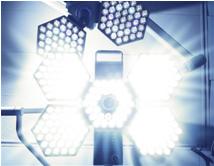
A Brief History of Surgical Lighting
Up until the invention of the electric light, a great deal of surgical lighting was provided by natural sunlight. Hospital operating rooms were constructed facing southeast with windows installed in the ceiling to allow the room to get as much sunlight as possible. Mirrors were often used to focus light on needed areas. Weather conditions and the time of day often influenced when procedures could be done.
In the late 1880s, electric lights were introduced to hospitals, but early lights posed problems of their own. Early electrical lights created poor illumination, and the heat generated by them was often unbearable. As lighting technology improved, surgical lights became more practical and helpful for doctors and nurses, and are now an important, if unsung, contributor to our high standard of modern health.
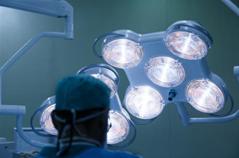
In the past decade, significant advancements in surgical lighting have made this technology more useful and effective in aiding doctors to perform more accurate and successful procedures. Many of these strides have been driven by better surgical procedures and evolving lighting choices.
Types of Surgical Lighting
Doctors and physicians have a variety of light sources to choose from, with each type having its own individual strengths and weaknesses. In general, there are
three types of surgical lights used by physicians:
- Halogen lights Halogens improve upon the incandescent lamps previously used in health care settings. Halogen lamps produce light by conducting electrical current through tungsten wire encased in a glass bulb filled with inert halogen gas. Halogen lights produce bright light and are typically long lasting. One major drawback of halogen lamps is that they tend to get very hot, often making them uncomfortable and inconvenient in surgical settings.
- Gas discharge lamps These lamps create light by conducting electrical current through ionized gas. This produces an electrical discharge that provides illumination. Gas discharge lamps last longer than halogen bulbs and are more efficient, but they also cost more because their manufacturing process is more complicated than that of halogen bulbs. Theyre also quite complicated to operate, as precise electronic devices are needed to provide stable operation. Its hard to restart a gas discharge lamp after it has been deactivated, theyre slow to reach full illumination, and dimming the light without changing light color is difficult. Surgeons using gas discharge lamps often have another type of lamp nearby as a backup.
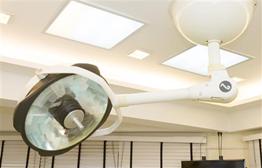
- LED Lights LED lights are the most recent advancement in surgical lighting technology. These devices emit light by conducting electrical current through semiconductor material. LEDs have many advantages over the more traditional forms of lighting. LEDs last longer than traditional lights and are also much more energy-efficient. Experts estimate LEDs last up to 40 times longer than halogen bulbs.
- LED lights generate far less heat than traditional light sources. Reduced heat is helpful in a number of ways in a surgical environment. Surgeons and nurses are more comfortable, allowing them to perform better, particularly in multi-hour surgeries. Less heat delivered to the surgical site also reduces the risk of exposed tissue drying out during surgery.
- LEDs emit white light, instead of the yellow light emitted by traditional light sources. The white light offers a more accurate view of the area surgeons are observing. LEDs are also smaller and thinner than traditional light sources, giving surgical lighting designers more options for creating a useful and convenient lighting system for doctors.
Considerations When Choosing Surgical Lighting
Surgical illumination is typically very safe, so long as lights are used properly by trained staff. Choosing the right lights for a particular health care setting is also important to doctor and patient safety.
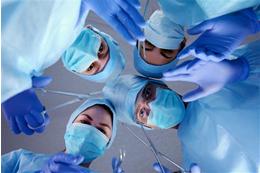
One of the biggest trends in surgical lights over the past few decades has been the increase in light output. Light output has increased dramatically over the past 30 years. From the 1960s to the 1980s, light output peaked between 80,000 to 110,000 lux. In the 1990s, peak output increased to around 130,000 lux. Now peak output ranges anywhere from 100,000 to 160,000 lux. Most top lighting products have a maximum output of around 140,000 lux.
The greater light output means better visibility for surgeons and nurses, thus reducing the chance of error during surgical procedures. The downside of increased illuminance is that it can generate excess heat.
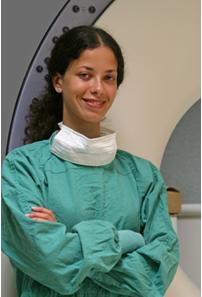
Too much heat can make medical personnel performing operations uncomfortable, increasing the likelihood of mistakes. Also, excess heat can cause thermal damage to patients undergoing surgery. Too much heat generated by surgical illumination can cause drying or ulceration of tissue exposed during a surgical procedure. In some cases, it can cause thermal burns.
The risk of thermal damage is significant during procedures such as neurosurgery or operations involving thin, hyperemic tissues.
Certain patients are at greater risk of thermal damage from surgery than others. Pediatric patients and patients with circulation problems may be at increased risk of thermal damage during surgery. Other at-risk patients include:
- Older patients Elderly adults may be more photosensitive than younger patients.
- Patients with certain diseases Diabetic patients, patients with auto-immune disorders, and patients undergoing radiation therapy may be more sensitive to heat than others.
- Surgery location Neurological procedures and some intestinal procedures may leave delicate tissue exposed. Too much heat can cause this tissue to dry.
- Medications Patients taking antibiotics, anti-cancer drugs, estrogens, NSAIDS, and other medications may be overly sensitive to bright light and heat.
Medical staff safety is another critical element of good surgical illumination. Surgical lights need to be designed to have safe areas on the lighting, where the position of the lights can be adjusted without causing injury or discomfort to doctors or nurses moving the lights.

Surgical Light Performance
Light and heat arent the only concerns for medical professionals purchasing surgical lighting products. Other factors need to weigh into the decision, such as:
- Illumination Tissues and organs dont reflect well, and often absorb a lot of light, making it critical that surgical lighting products produce enough light for accurate viewing of the area being operated on by surgeons. Professionals need to ensure the lights they purchase provide sufficient illumination.
- Reducing Shadows Shadows can impair perception accuracy in surgical settings. Surgical illumination products need to remove unwanted shadows. There are two types of shadows: contour shadows and contrast shadows. Contour shadows are helpful, as they let surgeons tell the difference between vasculature and fine tissue striations. Contrast shadows are problematic, in that they can obscure areas surgeons need to see. Good lighting will reduce contrast shadows cast by hands or instruments while retaining good contour shadows.
- Color temperature Lights with low color temperature may cause objects to appear pink or red, while light with high temperature may make objects look blue. Either way, it impairs visual accuracy.
- Control Surgeons need to be able to control the focus and intensity of light. Light creating too large of a field may cause a glare, while too small a field may also cause problems. Good surgical lights will allow surgeons a high level of control.
Medical Device Depot
carries a wide range of surgical lighting products, including the latest LED lights. The company has a trained, knowledgeable staff that can answer all questions regarding products, and Medical Device Depot is committed to offering the most competitive prices on all medical equipment.






